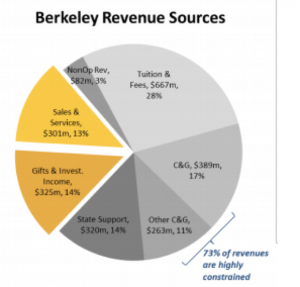In our previous post discussing a graph we constructed that compared mobility rate, endowments and top-tier public and private schools, there were two points that immediately took our interest. UCLA and UC Berkeley has a much higher mobility rate than any other school listed yet they are towards to lower end of the endowments.
The question we want to ask is: WHY?
We decided to look into the allocation of UC Berkeley’s endowments to see if they were spending their money on certain areas that could attribute to their students’ success.

This was tough. The information I could find online required some sort of financial or banking knowledge, neither of which I have. Apparently, they do not readily hand out information on the specific allocation of endowments online, so it is definitely something we want the Equality of Opportunity Project to get data on.
From what we gathered from the Office of the Chief Financial Officer on UC Berkeley Budget Plant, about $325 million comes from endowments. UC Berkeley receives an endowment of about $1.58 billion. State support nearly matches that amount in revenue sources. Looking at Trish’s post before this, Emory University has a $6.7 billion endowment: over 4X the amount of Berkeley’s. Yet, their spendable portion ($318.2 million) is less than Berkeley’s ($325 million). Interestingly enough, Emory’s mobility rate is 3.6% while UC Berkeley’s rate is 8.8% and UCLA’s is 10.2%. Maybe it is not the endowment itself, but the spending portion of the endowments that go into the schools.
Do endowments really play a factor into success of the students? Keep in mind, the lower end of endowments of the top tier schools are still from $1-3 billion. Obviously, all schools need a certain amount of money to provide students with professors, equipment and resources to guarantee a higher education. However, there might be a threshold to which success can be attributed to endowments. Nevertheless, we can only attempt to point out the patterns we see. To truly study this aspect of colleges, there needs to be access to the information regarding the allocation of these funds.
